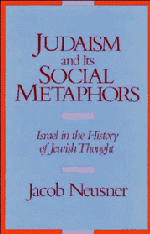Book contents
- Frontmatter
- Contents
- Preface
- List of Abbreviations
- Introduction
- 1 Imagining Society, Re-visioning “Israel”
- PART I “Israel” in the First Statement of Judaism, 70–300 C.E.
- 2 “Israel” in Relationship to Heaven
- 3 “Israel” in Relationship to “Non-Israel”
- 4 “Israel” in the Mishnah, the Tosefta, and Tractate Abot: A Probe
- 5 The First Phase of the Judaism of the Dual Torah and Its Social Metaphors
- PART II “Israel” in the Second Statement of Judaism, 300–600 C.E.
- PART III Same Metaphors, Other Systems
- General Index
- Index to Biblical and Talmudic References
5 - The First Phase of the Judaism of the Dual Torah and Its Social Metaphors
Published online by Cambridge University Press: 04 August 2010
- Frontmatter
- Contents
- Preface
- List of Abbreviations
- Introduction
- 1 Imagining Society, Re-visioning “Israel”
- PART I “Israel” in the First Statement of Judaism, 70–300 C.E.
- 2 “Israel” in Relationship to Heaven
- 3 “Israel” in Relationship to “Non-Israel”
- 4 “Israel” in the Mishnah, the Tosefta, and Tractate Abot: A Probe
- 5 The First Phase of the Judaism of the Dual Torah and Its Social Metaphors
- PART II “Israel” in the Second Statement of Judaism, 300–600 C.E.
- PART III Same Metaphors, Other Systems
- General Index
- Index to Biblical and Talmudic References
Summary
“Israel” as Chosen Metaphor
The most surprising metaphor operative in the Mishnah and related writings as they take up the social entity, the social group they have chosen to discuss, has not yet received notice. But it is scattered across the surface of all of the writings, the simple allusion to “Israel” when speaking of the “us” of Jewry today. When sages spoke of “Israel,” the word bore two identical meanings: the “Israel” of the Jews now and here, but also the “Israel” of which Scripture – the Torah – spoke. That word choice, which applies to both individual and social group, comes prior to all definitions of who and what (an) “Israel” is. And the word dictates for the system all of the metaphors, both in the first and in the second phases of the documents. What “Israel” accomplishes therefore is the simple but astonishing comparison of the Jews of the here and now to that “Israel” of which Scripture speaks.
That metaphor, flowing from the metaphorization of the group to begin with, constituted no given. Nothing imposed upon sages the comparison of the defeated people of the villages and households with the social entity of which Scripture tells. Treating the group within the perspective of a metaphor is not unique to sages. But deeming the given group to constitute “Israel” of which Scripture had spoken formed a remarkable choice.
- Type
- Chapter
- Information
- Judaism and its Social MetaphorsIsrael in the History of Jewish Thought, pp. 83 - 92Publisher: Cambridge University PressPrint publication year: 1989



